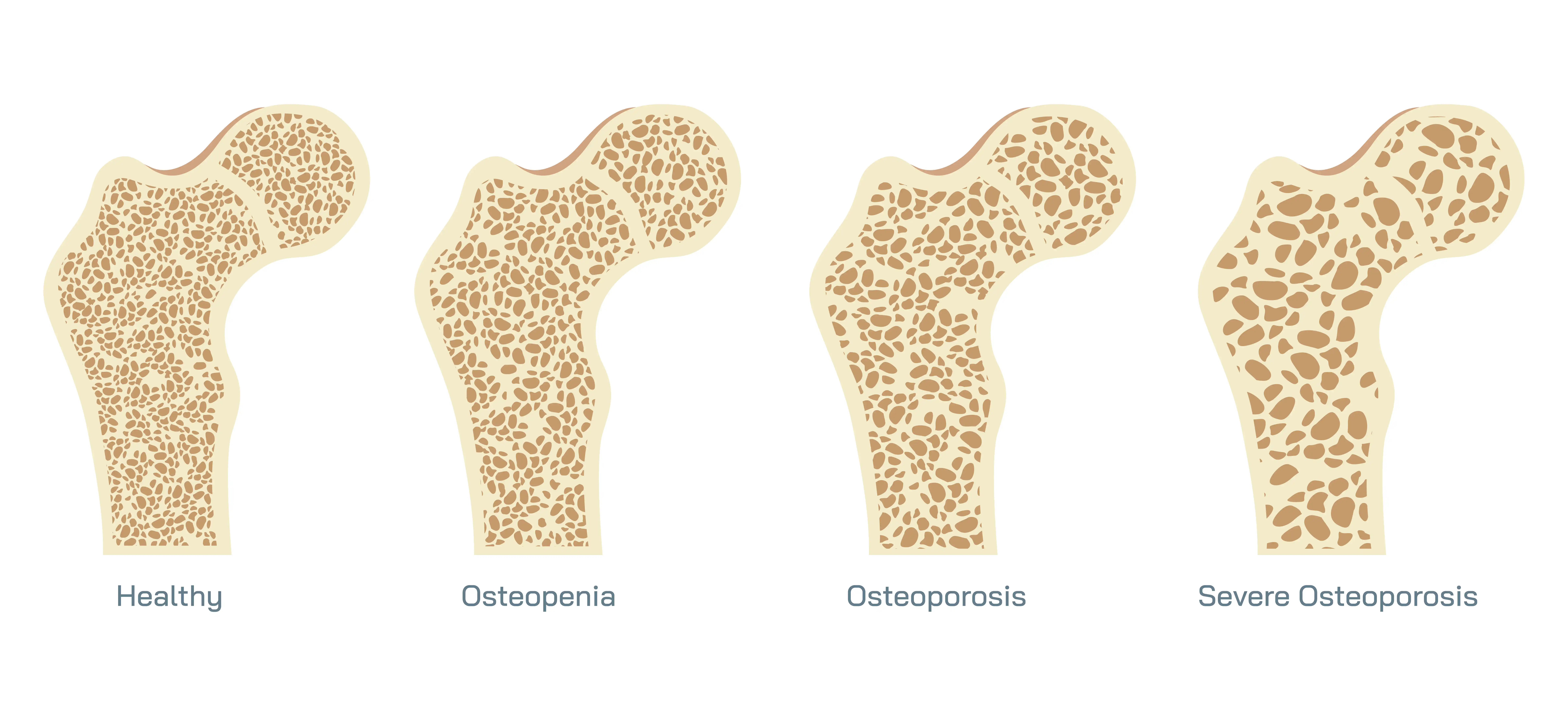Osteoporosis weakens bones, making them prone to fractures. It’s common, especially in older adults and postmenopausal women. Unlike injuries with immediate symptoms, osteoporosis often goes unnoticed until a bone breaks. This post covers its causes, how to recognize it, and ways to prevent and manage it.
Key Takeaways
- Osteoporosis is a bone disease characterized by reduced bone density. It increases fracture risks, especially in vulnerable areas like the hip, shoulder, wrist, and spine.
- Risk factors for osteoporosis include non-modifiable factors (age, gender, genetics) and lifestyle choices (nutrition, activity levels).
- Preventive measures include a balanced diet rich in calcium and vitamin D, regular weight-bearing exercise, and routine screenings.
Understanding Osteoporosis
Osteoporosis is a silent bone disease that gradually weakens bones from the inside out. Over time, bones lose density and their internal structure becomes more porous. When the reduction in bone mass exceeds a critical threshold, the risk of fractures significantly increases. Bones affected by severe osteoporosis can break from minor falls or even normal stresses, such as bending over or coughing.

Osteoporosis significantly increases the risk of fractures in key joints such as the hips and shoulders.
The hip, as a primary weight-bearing structure, is especially vulnerable; diminished bone density can lead to serious fractures even from minor falls.
The shoulder, particularly the proximal humerus, is another common site for osteoporotic fractures due to its wide range of motion and the demands placed on its supporting structures.
Understanding osteoporosis is the first step towards recognizing its impact on bone health and taking proactive measures to prevent and manage it effectively.
Who is at Risk for Osteoporosis?
While osteoporosis can affect anyone, these factors can increase an individual’s risk:
- Older age increases susceptibility as bones naturally become thinner and weaker over time.
- Women are at higher risk because they start with less bone mass and experience accelerated bone loss from menopause due to hormonal changes.
Additional risk factors include small body frame, Caucasian or Asian ethnic background, family history and genetic predisposition, and lifestyle choices like poor nutrition or inactivity. Early recognition of these risk factors can identify individuals who need further evaluation and preventive action.
Symptoms and Diagnosis of Osteoporosis
Osteoporosis is often considered a silent condition, as many individuals experience no obvious symptoms until they suffer a fracture. This lack of noticeable symptoms can make early detection challenging.
However, knowing the potential signs and utilizing diagnostic tools can help in identifying and managing the condition before significant damage occurs.
Identifying Symptoms
Common signs of osteoporosis include sudden bone fractures, unexplained back pain, height loss, and changes in posture. Individuals may experience back pain when a small bone in the spine is fractured. Loss of height may occur gradually due to compression fractures in the vertebrae, and a noticeable stooped posture can develop as a result of weakened vertebrae.
Diagnostic Tools
DXA scans measure bone density and are often used to diagnose osteoporosis. These scans provide a detailed assessment of an individual’s bone mineral density, helping to identify low bone mass and its severity by comparing it to a healthy 30-year-old.
Quantitative computed tomography (QCT) offers advantages such as separate bone mineral density estimates and sensitivity to change over time, although it comes with a higher radiation dose. Quantitative ultrasound, while beneficial for its lack of radiation and quick, easy measurements, is not used alone for diagnosis.
Your doctor will recommend testing based on your age, risk factors, and whether you’ve had fractures. These tests determine the presence and severity of low bone density, guiding treatment and management.
Causes of Osteoporosis
Several factors contribute to the development of osteoporosis:
- Hormonal changes, particularly low estrogen and testosterone levels, can increase bone density loss.
- Pregnancy-related osteoporosis may occur when hormonal changes affect bone density during and after pregnancy.
- Long-term use of certain medications, like glucocorticoids and corticosteroids, can lead to decreased bone density and disrupt the process of bone rebuilding.
Chronic conditions such as celiac disease and rheumatoid arthritis are associated with a higher likelihood of developing osteoporosis. Genetics also plays a role.
In men, secondary osteoporosis, caused by other conditions, can be linked to hypogonadism and chronic diseases. These account for up to 60% of cases in men. Unhealthy lifestyle choices, such as smoking and excessive alcohol consumption, further increase the risk.
Assessing Fracture Risk
Evaluating fracture risk is a critical step in osteoporosis prevention and management, particularly for high-risk individuals.
A prior fragility fracture is a strong indicator of future likelihood of breaks and should prompt further assessment. Men experience about 1% annual loss in bone mineral density and tend to sustain fractures later in life than women.
The FRAX tool helps estimate fracture risk based on clinical risk factors and guides the need for bone mineral density (BMD) testing. Women with risk factors should receive a FRAX assessment at age 50, while routine BMD testing typically begins at 65 for women and 70 for men.
Taking a proactive approach in assessing susceptibility to fractures allows for early intervention through lifestyle modifications and treatment when needed.
Lifestyle Changes for Bone Health
Maintaining strong bones requires attention to diet and daily habits. Modern diets often lack sufficient calcium. A deficiency of calcium over time can reduce bone density and increase the risk of fractures. Alongside ensuring adequate calcium intake, avoiding smoking and limiting alcohol protects bone health. Furthermore, regular physical activity builds muscle strength, supports bones, and enhances balance.
These lifestyle factors are especially important for younger individuals, as poor nutrition and inactivity during peak bone-building years can have lasting consequences.
Exercise and Physical Activity
Regular physical activity, especially weight-bearing and resistance exercises, serves as one of the most effective ways to preserve and strengthen bones.
Weight-Bearing Exercises
Weight-bearing activities, such as walking or dancing, directly stimulate bone health by forcing the body to work against gravity.
Strengthening exercises specifically targeting the upper back can also enhance posture, which is particularly valuable for those already experiencing spinal changes from osteoporosis.
Resistance Training
Resistance training strengthens not only the muscles but also the bones, which can help reduce the risk of fractures. Utilizing free weights or resistance bands in strength training can be tailored to accommodate individual levels of comfort and ability.
For optimal results, a combination of weight-bearing and resistance exercises should be performed regularly, adapted to each individual’s capabilities. This dual approach not only supports bone health but also improves balance and muscle strength, reducing the overall risk of falls and fractures.
Pharmacologic Treatments for Osteoporosis
Various medications are available for treating osteoporosis, including bisphosphonates and selective estrogen receptor modulators (SERMs). Bisphosphonates have been known for alleviating pain and enhancing the quality of life for patients with osteoporosis. These drugs work by inhibiting bone breakdown. Available as oral tablets or intravenous infusions, bisphosphonates may reduce fracture risk while improving quality of life.
For postmenopausal women, SERMs can offer dual benefits: increasing bone density while reducing invasive breast cancer risk. However, it comes with potential side effects like hot flashes, muscle spasms, and an increased risk of blood clots, requiring careful patient evaluation.
Nutritional Supplements for Bone Health
A bone-healthy diet focuses on two key nutrients: calcium and vitamin D. Beyond these, several other nutrients also play roles in bone remodeling and strength.
Calcium and Vitamin D
Calcium serves as the primary building block for bones, with dairy products, leafy greens, and fortified foods being the optimal sources. Some individuals may require supplements to meet the recommended daily intake.
Vitamin D’s role is equally important, facilitating the absorption of calcium and regulating bone metabolism. While sunlight triggers natural vitamin D production, many individuals may need supplementation. Research suggests Vitamin D may also alleviate musculoskeletal pain and reduce inflammation in postmenopausal osteoporosis patients.
Other Essential Nutrients
Other nutrients, such as magnesium, vitamin K, protein, and potassium, also play significant roles in bone remodeling, where damaged bone tissue is removed and new bone tissue is formed.
A well-rounded diet with fruits, vegetables, and lean proteins typically provides these nutrients. However, patients should consult their doctor before starting supplements, as individual needs vary based on health status and medications.
Managing Osteoporosis-Related Complications
Effective management of osteoporosis complications focuses on preserving mobility and quality of life. Chronic pain often involves both bone pain and nerve-related discomfort, requiring comprehensive treatment. Targeted physical activities like yoga and Pilates can help to improve strength and flexibility while reducing discomfort. Cognitive-behavioral therapy may further complement these physical interventions by helping patients develop coping strategies for persistent pain.
Special Considerations
While osteoporosis affects many individuals, some populations require unique attention. Recognizing and understanding these special considerations is important for effective prevention and management strategies.
This section will explore osteoporosis in men and pregnancy-associated osteoporosis.
Osteoporosis in Men
While men benefit from higher peak bone mass, they still experience gradual bone loss with age. Despite the high risk of fractures, osteoporosis is often overlooked in men, with only about 10% receiving appropriate treatment. Men are less frequently evaluated and treated for osteoporosis after experiencing fractures compared to women.
Male-specific osteoporosis management may involve hormone therapy, lifestyle changes, and medications that address their specific health needs.
Pregnancy-Associated Osteoporosis
Pregnancy-associated osteoporosis is a rare condition that causes unexpected bone density loss during or after pregnancy. The exact cause of osteoporosis during pregnancy and lactation remains unknown, contributing to the challenges in managing maternal bone health.
Careful monitoring and management strategies are essential for ensuring the health of both mother and baby.
Preventing Osteoporosis
Building and maintaining strong bones requires lifelong attention, starting from childhood and teenage years when bone mass significantly develops. The foundation for osteoporosis prevention combines nutrition, activity, and regular monitoring.
Daily calcium requirements increase to 1,200 milligrams for older adults after age 50 to support bone health. Vitamin D intake should be 800-1,000 international units daily for those over 50 to maintain bone health. Aim for a balanced diet that incorporates dairy, leafy greens, and supplements if needed.
Lifestyle choices also matter. Avoiding smoking and limiting alcohol intake to no more than two drinks per day are recommended to preserve bone density. Regular weight-bearing activity and resistance training are beneficial. Most importantly, consult a doctor for personalized advice tailored to your personal risk factors.
The U.S. Preventive Services Task Force recommends osteoporosis screening for women over 65. Individuals should ask about bone density testing before age 65 if they have risk factors for osteoporosis.
Summary
In summary, osteoporosis is a serious condition that silently affects bone health, increasing the risk of fractures. Understanding the risk factors, symptoms, and causes can help in early detection and effective management. This condition stems from multiple factors, including aging, hormones, and lifestyle, yet responds to early intervention. Lifestyle changes, including a balanced diet and regular exercise, play a crucial role in maintaining bone health. Pharmacologic treatments and nutritional supplements further support bone strength and health, while managing complications and special considerations help improve the quality of life for affected individuals.
Taking proactive measures to maintain bone health is essential. By incorporating the strategies discussed in this blog post, you can significantly reduce your risk of developing osteoporosis and ensure a healthier, more active life. Remember, it’s never too early or too late to start taking care of your bones.
Frequently Asked Questions
What are the primary risk factors for developing osteoporosis?
The primary risk factors for developing osteoporosis are gender, with women at higher risk, older age, smaller body size, ethnic background, and a family history of the disease. Understanding these factors can help in taking preventive measures.
How is osteoporosis diagnosed?
Osteoporosis is diagnosed primarily through DXA scans to assess bone mineral density, along with other methods such as quantitative computed tomography (QCT) and quantitative ultrasound, ensuring accurate assessment of bone health.
What lifestyle changes can help prevent osteoporosis?
Prioritize three pillars: nutrition (calcium and vitamin D), regular weight-bearing exercise, and avoiding smoking and excessive alcohol use. These changes are essential for maintaining strong bones.
What medications are available for treating osteoporosis?
Bisphosphonates and selective estrogen receptor modulators (SERMs) may be effective medications for treating osteoporosis, as they help to inhibit bone resorption and increase bone mineral density.
How can osteoporosis-related complications be managed?
Osteoporosis-related complications can be effectively managed through a comprehensive treatment strategy that includes physical exercise, cognitive-behavioral therapy, and, when necessary, surgical intervention by an orthopedic surgeon to address fractures or structural issues.





